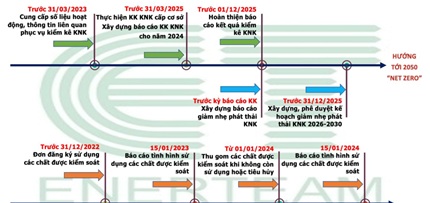According to Dr. Nguyen Trung Thang, Deputy Director of the GEF/ADB Project Management Board "Integrating climate change resilience and environmental protection to develop green urban areas of type II" of the Ministry of Agriculture and Environment expressed: "It is impossible to talk about reducing emissions if we do not know how much and where we are emitting. Import-in-port inventory helps answer those questions, creating a scientific foundation for building a roadmap, allocating responsibilities and selecting appropriate solutions for each industry and each locality. The more complete and standardized the inventory data, the closer the policy is to reality.
Vietnam is one of the countries heavily affected by climate change. To implement emission reduction commitments, especially the goal of net zero emissions by 2050, building a legal corridor for greenhouse gas inventories (GSIs) becomes an urgent requirement. This is also the basis for Vietnam to fulfill its international responsibility, while protecting the livelihoods of people in areas affected by natural disasters and rising sea levels. GHG inventory is no longer a simple administrative procedure, but a starting point for data-based emission management and the orientation of shifting to a green growth model.
The Party's policy has laid the foundation for this activity. Resolution No. 24-NQ/TW in 2013 identifies climate change response as not only a challenge but also an opportunity to promote the transformation of the growth model towards sustainable development, requiring investigation, statistics, inventory and planning for emission reduction in accordance with the conditions of each region and each field. On that basis, the legal system on environmental protection is amended in the direction of strengthening GHG emission management, linking responsibility between the Central and local governments.
The 2020 Environmental Protection Law marks a turning point when for the first time a separate chapter on climate change response is devoted, including reducing GHG emissions and developing a carbon market. The law stipulates that large issuers must inventory, develop a roadmap for emission reduction and gradually participate in the carbon credit market. Therefore, businesses are no longer left out of the process of responding to climate change but have become the subject accompanying the State.
On the basis of the Law, the Government issued Decree No. 06/2022/ND-CP on greenhouse gas emission reduction and odon layer protection and Decision No. 13/2024/QD-TTg stipulating the list of establishments that must conduct import-export inventories. These documents create a synchronous legal framework, clearly defining the responsibilities of ministries, branches and localities in implementing GHG inventories; at the same time, establishing a mandatory roadmap for more than 2,000 large emissions facilities nationwide.
Overall, from the Party's policies, the National Assembly's legal framework to decrees and guiding circulars, Vietnam has formed a relatively complete legal corridor for import-export inventories. The core issue today is to turn that framework into real action. If done well, import-export inventories will not only meet reporting requirements, but also become a lever to help businesses improve competitiveness and help localities manage and develop in a green direction, better adapting to climate change.












